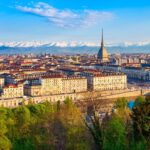Italy is a country renowned for its exquisite beauty, rich history, and vibrant culture. From the enchanting canals of Venice to the ancient ruins of Rome, Italy has something to offer every traveler. However, when planning a trip to this captivating nation, one must face the question – northern or southern Italy?
Each region holds its own allure and unique experiences, making the decision all the more difficult. In this article, we will explore the differences between northern and southern Italy in terms of geography, climate, cultural heritage, gastronomy, iconic cities, natural wonders, art and architecture, as well as unique experiences. By the end of this journey through Italy’s splendors, readers will be better equipped to choose which part of this magnificent country suits their preferences.
Italy captivates visitors with its diverse landscapes and rich cultural heritage. The contrasting geography and climate between northern and southern Italy play a major role in shaping their distinct characteristics. In the north, one can find picturesque scenes of snow-capped mountains such as the Alps that dominate the horizon.
On the other hand, southern Italy boasts sun-drenched beaches along its stunning Mediterranean coastline. Understanding these geographical differences allows travelers to tailor their experience according to their preferences – whether it be exploring charming mountain towns or soaking up sun on golden shores.
Moreover, each region is steeped in centuries of history and cherished traditions that have shaped its culture. Northern Italy showcases a tapestry of historical influences from various European civilizations that have left an indelible mark on cities like Milan and Florence. Conversely, southern Italy exudes an unmistakable Mediterranean flair with its deep-rooted traditions and historical landmarks such as Pompeii and Capri. Both regions offer an immersive cultural experience but with their own distinctive flavors.
One cannot speak about Italy without mentioning its delectable cuisine. Northern Italian cuisine is famous for its rich pasta dishes like tortellini and ravioli alongside gourmet specialties like risotto and polenta. In contrast, southern Italy boasts a culinary delight of fresh seafood, vibrant vegetables, and the iconic Neapolitan pizza. The gastronomic traditions of each region are a testament to the diverse natural resources available, making it a tantalizing prospect for any food lover.
In the coming sections, we will delve into these aspects in greater detail, uncovering the hidden gems and iconic landmarks that await travelers in northern or southern Italy. Choosing between these two beloved regions may be a challenging decision, but one thing is certain – an extraordinary journey through history, culture, gastronomy, and natural wonders awaits those who embark on an adventure to Italy’s northern or southern shores.
So pack your bags and prepare to immerse yourself in the treasures of this remarkable country.
Geography and Climate
Italy, with its diverse and captivating landscapes, offers a unique experience for travelers. When deciding between Northern and Southern Italy, one of the key factors to consider is the geography and climate of each region.
In Northern Italy, visitors will be treated to a contrasting landscape that spans the majestic Alps in the north to the picturesque lakes and charming countryside in the south. The rugged beauty of the mountainous regions provides endless opportunities for outdoor activities such as hiking, skiing, and mountaineering. On the other hand, the stunning lakes, including Lake Como and Lake Garda, offer a serene escape with their crystal-clear waters and scenic surroundings.
The climate in Northern Italy also varies significantly depending on location. The alpine regions experience colder temperatures and heavier snowfall during winter months, making it an ideal destination for winter sports enthusiasts. As you move further south towards cities like Milan or Venice, the climate becomes more temperate with mild winters and hot summers. The coastal areas along the Adriatic Sea enjoy a Mediterranean climate characterized by warm summers and mild winters, making it perfect for beach lovers.
On the other hand, Southern Italy boasts a completely different geography and climate. With its sun-drenched landscapes and stunning coastline along the Mediterranean Sea, Southern Italy offers a truly Mediterranean experience. The region is known for its iconic beaches that rival some of the best in Europe including Positano’s breathtaking Amalfi Coast.
The climate in Southern Italy is predominantly Mediterranean with hot dry summers perfect for enjoying sun-soaked days on the beach. Winters are mild with occasional rainfall making it an enjoyable time to explore historical landmarks without heavy crowds. The southern region also benefits from fertile soil which contributes to lush vegetation such as vibrant citrus orchards and olive groves.
Whether you prefer exploring snow-capped mountains or lounging under sunny skies on picturesque beaches, both Northern and Southern Italy offer unique geographical features that cater to different preferences. By considering these contrasting landscapes and climates, travelers can make an informed decision on which part of Italy to explore based on their personal interests and desired experience.
Cultural Heritage
Italy is a country renowned for its rich cultural heritage, and nowhere is this more evident than in the stark contrasts between Northern and Southern Italy. Each region boasts a distinct history, traditions, and influences that have shaped their unique identities. Exploring the cultural heritage of these two Italys provides visitors with an opportunity to delve into centuries of art, architecture, music, and folklore.
Northern Italy holds a prominent place in Italian history as the birthplace of the Renaissance. From the grandeur of Milan’s Gothic Duomo to Florence’s iconic Uffizi Gallery showcasing masterpieces by Michelangelo and Botticelli, the cities in this region are veritable treasure troves. The intellectual and artistic movements that flourished during this period have left an indelible mark on Northern Italy’s cultural landscape.
On the other hand, Southern Italy exudes a charm rooted in ancient civilizations that have inhabited the region for centuries. With Naples as its crown jewel, Southern Italy captures the essence of Neapolitan culture with its vibrant street life, lively music scene, and delectable cuisine. The ruins of Pompeii serve as physical reminders of how deeply rooted Southern Italy’s historical legacy truly is.
The two Italys also differ in terms of architectural styles. In Northern Italy, one can marvel at magnificent cathedrals adorned with intricate frescoes or explore medieval castles nestled amongst rolling hills. Meanwhile, Southern Italy boasts historical gems like Rome’s Colosseum – an awe-inspiring testament to the grandeur of Ancient Rome – along with stunning examples of Baroque architecture found throughout Sicily.
Whether your interests lie in exploring masterpieces from renowned artists or stepping back in time amongst ancient ruins, both Northern and Southern Italy offer a wealth of cultural experiences waiting to be discovered. It ultimately comes down to personal preference – whether you’re drawn to the intellectual wonders bathed in Renaissance glory or captivated by the vibrant tapestry of history and folklore that permeates Southern Italy, both regions promise an immersive cultural journey.
Gastronomy
Italy is renowned for its exceptional cuisine, creating a gastronomic paradise for food lovers. When deciding between traveling to Northern or Southern Italy, one must consider the distinct flavors and culinary experiences each region has to offer.
In Northern Italy, food enthusiasts can indulge in a variety of rich pasta dishes and gourmet specialties. This region is famous for its hearty risottos, such as the classic risotto alla Milanese, infused with saffron threads. Another popular dish is tortellini, small stuffed pasta parcels usually filled with a mix of meat and cheese. Northern Italy also boasts delectable cured meats like prosciutto di Parma and mortadella, as well as the world-renowned Parmigiano-Reggiano cheese.
On the other hand, Southern Italian cuisine showcases fresh seafood, vibrant vegetables, and the iconic Neapolitan pizza. The coastal regions of Southern Italy provide an abundance of delectable seafood options including grilled calamari, seafood pasta dishes like spaghetti alle vongole (clams), and mouthwatering fried anchovies. Additionally, traditional Southern Italian cuisine embraces ingredients like tomatoes, eggplants, and basil in its flavorful dishes such as caponata – a sweet and sour eggplant relish.
| Northern Italian Cuisine | Southern Italian Cuisine |
|---|---|
| Risotto alla Milanese | Neapolitan Pizza |
| Tortellini | Spaghetti alle Vongole (Clams) |
| Prosciutto di Parma | Grilled Calamari |
| Parmigiano-Reggiano cheese | Caponata (Sweet and sour eggplant relish) |
No matter which region one chooses to explore, food lovers are guaranteed an unforgettable culinary journey through Italy. Whether it’s savoring a bowl of creamy risotto in the North or biting into a mouthwatering Neapolitan pizza in the South, the flavors and gastronomy of Italy will leave travelers craving for more.
Iconic Cities
Northern and Southern Italy each boast a collection of iconic cities that showcase the unique charm and cultural heritage of their respective regions. Travelers are often faced with the difficult decision of choosing between visiting the enchanting allure of Northern cities like Venice, Milan, and Florence or exploring the vibrant charm of Southern cities such as Rome, Naples, and Sicily. Both options offer an abundance of history, art, architecture, gastronomy, and unforgettable experiences.
In Northern Italy, Venice stands out as one of the most iconic cities in the world. Known for its romantic canals and stunning architecture, Venice offers a truly unique experience. Visitors can wander through narrow streets, take gondola rides along the Grand Canal, and admire masterpieces in art galleries such as the Gallerie dell’Accademia.
Milan is another must-visit city in Northern Italy. As a global hub for fashion and design, Milan showcases its modernity alongside historical treasures. The magnificent Duomo di Milano is a highlight, offering breathtaking views from its rooftop terrace. Art enthusiasts will also appreciate Da Vinci’s Last Supper at Santa Maria delle Grazie.
Florence is a city that transports visitors back in time to the Renaissance era. It boasts an unparalleled wealth of artistic treasures. The Uffizi Gallery houses works by masters such as Botticelli and Raphael, while Brunelleschi’s Dome atop Florence Cathedral offers panoramic views of the city.
On the other hand, Southern Italy captivates travelers with its historical richness embodied by Rome. Known as the “Eternal City,” Rome is a treasure trove of ancient ruins such as the Colosseum and Roman Forum. Vatican City is another must-visit destination for its awe-inspiring St. Peter’s Basilica and Sistine Chapel painted by Michelangelo.
Naples holds great significance for lovers of archaeology due to its proximity to Pompeii and Herculaneum-ancient Roman cities that were buried by the eruption of Mount Vesuvius. Naples itself is a bustling city known for its vibrant street life, delicious pizza, and historical sites like Castel dell’Ovo.
Finally, Sicily draws visitors with its rich history reflected in stunning architecture and diverse cultural influences. In Palermo, the capital of Sicily, you can explore Norman palaces, baroque churches, and local markets. The ancient Greek ruins in the Valley of Temples near Agrigento should not be missed either.
| City | Main Attractions | Cuisine |
|---|---|---|
| Venice | Rialto Bridge, St. Mark’s Square, Doge’s Palace | Seafood dishes like Sarde in Saor (marinated sardines), Risotto al Nero di Seppia (squid ink risotto) |
| Milan | Duomo di Milano, Galleria Vittorio Emanuele II, Sforza Castle | Risotto alla Milanese (saffron risotto), Ossobuco (braised veal shanks) |
| Florence | Duomo di Firenze, Uffizi Gallery, Ponte Vecchio | Bistecca alla Fiorentina (T-bone steak), Ribollita (vegetable soup) |
| Rome | Colosseum, Vatican City, Trevi Fountain | Cacio e Pepe (pasta with cheese and black pepper), Carbonara (pasta with egg, cheese, and pancetta) |
| Naples | Piazza del Plebiscito, Castel Nuovo, Naples Underground | Margherita pizza, Spaghetti alle Vongole (spaghetti with clams) |
| Sicily | Valley of Temples, Palermo Cathedral, Mount Etna | Pasta alla Norma (tomato-based pasta with eggplant), Arancini (fried rice balls) |
Whether you choose to explore the iconic cities of Northern Italy or immerse yourself in the vibrant charm of Southern Italy’s urban centers, both regions offer an incredible journey filled with history, art, gastronomy, and unforgettable experiences. The decision ultimately depends on your preferences and interests. No matter which region you choose to visit, Italy promises an adventure that will leave a lasting impression.
Natural Wonders
Italy is known for its stunning natural landscapes, from the majestic mountains to the pristine coastlines. Whether you choose to explore Northern or Southern Italy, you will be treated to an array of breathtaking natural wonders.
In Northern Italy, visitors have the opportunity to explore the picturesque lakes and mountains that dot the region. The Italian Lakes, including Lake Como, Lake Maggiore, and Lake Garda, offer tranquility and beauty like no other. These glacial lakes are surrounded by lush forests and quaint villages, providing a perfect escape for nature lovers.
Additionally, Northern Italy is home to the breathtaking scenery of the Dolomites mountain range. With soaring peaks and steep cliffs, this UNESCO World Heritage Site offers unparalleled hiking trails and opportunities for outdoor adventures. Visitors can immerse themselves in the awe-inspiring beauty of these mountains while enjoying activities such as skiing, rock climbing, and paragliding.
On the other hand, Southern Italy boasts some of the most captivating coastal paradises in Europe. The Amalfi Coast is renowned for its dramatic cliffs cascading into crystal-clear turquoise waters. This UNESCO-listed coastline is dotted with charming towns like Positano, Amalfi, and Ravello that offer a taste of la dolce vita. Visitors can soak up the sun on luxurious beaches or take scenic boat rides along the coast to admire hidden coves and grottoes.
Southern Italy is also famous for its breathtaking islands such as Sicily and Sardinia. These islands feature idyllic sandy beaches surrounded by azure waters that are perfect for swimming, snorkeling, and diving. Additionally, visitors can explore volcanic landscapes such as Mount Etna in Sicily or indulge in world-class seafood cuisine influenced by traditional coastal flavors.
No matter which part of Italy you choose to visit – Northern or Southern – you are guaranteed to be mesmerized by its natural wonders. From serene lakes and majestic mountains in the North to captivating coastlines and hidden island paradises in the South, Italy offers a diverse range of landscapes and experiences that will leave you in awe. So pack your bags and embark on a journey to discover the natural wonders that await you in Italy.
Art and Architecture
Northern and Southern Italy are both renowned for their rich artistic and architectural heritage. From magnificent works of art displayed in museums to historical landmarks that have stood the test of time, both regions offer an abundance of beauty for art enthusiasts and history buffs alike.
Artistic Masterpieces in Northern Italy
Northern Italy is home to some of the most iconic artworks in the world. Cities like Milan and Florence boast world-class museums that house masterpieces by legendary artists. In Milan, visitors can marvel at Leonardo da Vinci’s famous mural, the Last Supper, which is a true testament to his genius.
The city also offers a vibrant art scene with contemporary galleries showcasing innovative works by local and international artists. Furthermore, Florence showcases an astonishing collection of Renaissance art, including Michelangelo’s David at Galleria dell’Accademia and Botticelli’s Birth of Venus at Uffizi Gallery.
The Awe-Inspiring World of Southern Italian Architectural Marvels
Southern Italy has its fair share of architectural wonders that continue to captivate visitors from all over the world. Rome alone is a treasure trove of historical landmarks, such as the Colosseum, the Pantheon, and the Roman Forum. These ancient structures provide a glimpse into the grandeur of the past and leave visitors in awe of their engineering prowess.
Additionally, Pompeii offers a unique opportunity to explore one of the best preserved ancient cities in the world. Walking through its ancient streets and marveling at its well-preserved buildings is like stepping back in time.
Whether you choose to explore Northern or Southern Italy, you will be surrounded by an incredible wealth of art and architecture that spans centuries. From mesmerizing paintings to awe-inspiring ancient ruins, these regions offer an unforgettable journey through Italy’s rich cultural heritage. So pack your bags, grab your camera, and get ready for an immersive experience filled with beauty and wonder.
Unique Experiences
Italy is a country that is renowned for its history, art, architecture, and breathtaking landscapes. While the iconic cities and landmarks may be on every traveler’s list, there is another side to Italy that offers unique experiences that are often overlooked.
Both Northern and Southern Italy are brimming with hidden gems and local traditions just waiting to be discovered. Whether you choose to explore the winding alleys of Northern Italy’s charming villages or immerse yourself in the vibrant culture of Southern Italy’s traditional festivals, there is something for everyone.
Uncovering Hidden Gems in Northern Italy
Beyond the bustling cities of Venice, Milan, and Florence, lie hidden pockets of charm and beauty in Northern Italy. One such gem is the region of Piedmont where visitors can experience picturesque landscapes dotted with vineyards and taste some of the finest Italian wines. The town of Alba in Piedmont is especially famous for its truffles, attracting food enthusiasts from around the world.
For art lovers seeking a different kind of experience, a visit to Mantua in Lombardy is a must. This Renaissance city boasts architectural wonders such as Palazzo Ducale as well as breathtaking frescoes by Andrea Mantegna in the Camera degli Sposi.
For those looking to escape the crowds and immerse themselves in nature, Valle d’Aosta offers stunning mountain ranges perfect for hiking or winter sports. With its charming Alpine villages, castles, and thermal baths, this region provides a peaceful retreat amidst nature’s beauty.
Embracing Local Traditions in Southern Italy
Southern Italy is bursting with vibrant traditions that have been passed down through generations. One such tradition can be experienced during Easter when the town of Matera in Basilicata holds one of the most solemn processions – Processione dei Misteri. This centuries-old procession reenacts the passion and death of Christ through statues carried by the locals.
Music lovers will find their bliss in Naples, where the soulful sounds of traditional Neapolitan songs fill the streets. The folk music known as tarantella is a lively and energetic dance that captures the spirit of Southern Italy’s rich cultural heritage. Visitors can often stumble upon impromptu performances in local squares or catch a live concert to experience this authentic musical tradition.
Southern Italy is also home to numerous colorful and exuberant festivals. One of the most famous is the Carnival of Viareggio in Tuscany, known for its elaborate floats and parades filled with satire and political commentary. This lively celebration attracts thousands of visitors each year, providing an opportunity to indulge in local traditions while enjoying the festivities.
No matter which part of Italy you choose to explore, Northern or Southern, it is important to venture beyond the well-trodden path and discover the hidden gems and local traditions that make this country truly special. These unique experiences will offer a deeper understanding and appreciation of Italy’s diverse culture and heritage, creating memories that last a lifetime.
Conclusion
As the article comes to a close, it is clear that choosing between Northern and Southern Italy is no easy task. Both regions offer an abundance of beauty, rich cultural heritage, and unique experiences that are bound to leave visitors in awe. It ultimately boils down to personal preferences and priorities when deciding which part of Italy to explore.
For those seeking diverse landscapes and climates, Northern Italy presents a striking contrast from the snow-capped Alps to the Mediterranean coast. The region boasts charming countryside, majestic mountains, and picturesque lakes that will transport travelers into a world of natural wonders. On the other hand, Southern Italy offers the breathtaking beauty of the Amalfi Coast and its exotic beaches, showcasing a coastal paradise like no other.
Italy’s cultural heritage is deeply rooted in both regions, making it difficult to choose between them. Northern Italy celebrates historical significance and distinct cultural influences through artistic masterpieces housed in renowned museums. Southern Italy holds equal intrigue with its deep-rooted traditions and iconic landmarks such as the Colosseum and Pompeii.
One cannot discuss Italian culture without mentioning gastronomy. Both regions boast mouth-watering cuisine with distinctly different flavors. Northern Italy offers rich pasta dishes and gourmet specialties that will satiate even the most refined palate. In contrast, Southern Italian cuisine tantalizes taste buds with fresh seafood delicacies, vibrant vegetables, and traditional Neapolitan pizza.
Ultimately, whether choosing Northern or Southern Italy for your journey, both promise unforgettable experiences that will stay with you long after you have returned home. Each region offers its own unique charm, captivating allure, and hidden gems waiting to be discovered. So take some time to consider your preferences – do you long for stunning landscapes or vibrant cities?
Do you prefer indulging in rich pastas or fresh seafood? No matter what choice you make, a remarkable adventure awaits you in either Northern or Southern Italy.
Frequently Asked Questions
Is Northern Italy worth visiting?
Northern Italy is definitely worth visiting for its rich cultural heritage, stunning landscapes, and historic cities. The region is home to world-renowned gems such as Venice, Milan, and Florence. Venice’s charming canals, grand palaces, and vibrant art scene are truly fascinating. Milan is a fashion capital that blends modernity with historical landmarks like the iconic Duomo cathedral.
Florence, on the other hand, offers a glimpse into the Italian Renaissance with its magnificent architecture and numerous museums housing priceless masterpieces. Furthermore, Northern Italy boasts breathtaking natural beauty with the majestic Dolomite Mountains and picturesque lakes like Lake Como and Lake Garda. Overall, a visit to Northern Italy promises an incredible mix of history, culture, and natural splendor.
Is Southern Italy worth visiting?
Southern Italy is definitely worth a visit for those seeking a more relaxed and authentic Italian experience. The region brims with enchanting coastal towns such as Sorrento, Amalfi, Positano, and Capri that offer stunning views of the Mediterranean Sea along with delicious seafood specialties. The archaeological wonders of Pompeii and Herculaneum provide unique insights into ancient Roman life.
Additionally, southern regions like Calabria and Puglia boast pristine beaches and untouched landscapes perfect for those looking to unwind in idyllic surroundings. Furthermore, Sicily captures hearts with its rich history blending Greek temples with Baroque architecture while also offering diverse natural wonders like Mount Etna volcano. In terms of cuisine, the south serves up some of the best dishes in Italy including pizza from Naples or traditional pasta alla Norma from Sicily.
Is Northern Italy cheaper than Southern Italy?
It’s important to note that the cost of visiting each region in Italy varies depending on various factors such as accommodation choices and tourist season rather than solely north or south distinctions. However, generally speaking, Northern Italy tends to be more expensive than Southern Italy when it comes to accommodation rates due to the higher demand in major cities like Venice or Milan. On the other hand, Southern Italy often offers more affordable lodging options, especially in smaller towns and coastal areas.
Additionally, dining out and transportation costs can also differ between regions with Northern Italy being slightly pricier in some cases. It’s worth mentioning that both regions offer unique experiences, cultural attractions, and culinary delights that cater to various budgets, so it ultimately comes down to personal preferences and choices when deciding which region suits one’s budget.

I’m a passionate traveler, writer, and Italophile. My fascination with Italy’s history, art, and culture has led me on countless adventures across the Italian landscape. Through “I Live Italy,” I share my love for this extraordinary country and aims to inspire others to explore its boundless beauty.





